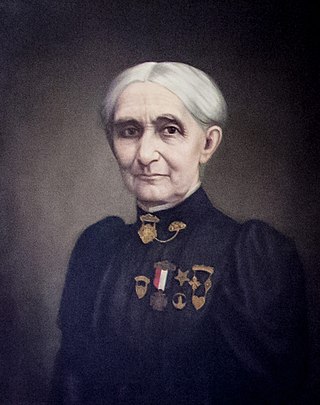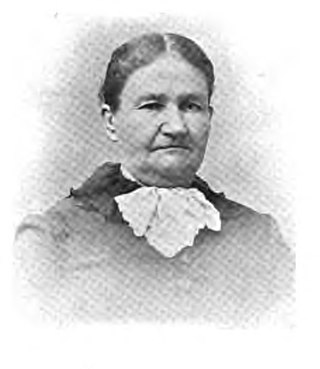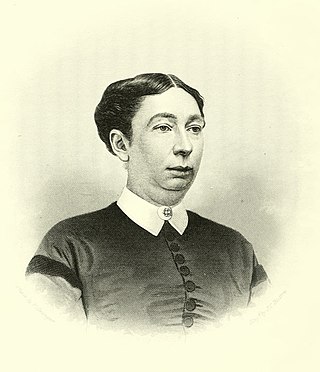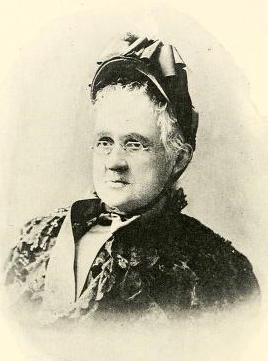Related Research Articles

Mary Ann Bickerdyke, also known as Mother Bickerdyke, was a hospital administrator for Union soldiers during the American Civil War and a lifelong advocate for veterans. She was responsible for establishing 300 field hospitals during the war and served as a lawyer assisting veterans and their families with obtaining pensions after the war.

Mary Ashton Livermore was an American journalist, abolitionist, and advocate of women's rights. Her printed volumes included: Thirty Years Too Late, first published in 1847 as a prize temperance tale, and republished in 1878; Pen Pictures; or, Sketches from Domestic Life; What Shall We Do with Our Daughters? Superfluous Women, and Other Lectures; and My Story of the War. A Woman's Narrative of Four Years' Personal Experience as Nurse in the Union Army, and in Relief Work at Home, in Hospitals, Camps and at the Front during the War of the Rebellion. She wrote a sketch of the sculptor Anne Whitney for Women of the Day and delivered the historical address for the Centennial Celebration of the First Settlement of the Northwestern States in Marietta, Ohio on July 15, 1788.

Harriet Patience Dame was a prominent nurse in the American Civil War. Her portrait hangs in the New Hampshire State House.

Mary A. Gardner Holland, also known as Mary G. Holland, was a Union nurse during the American Civil War.

Maria N. Abbey was a nurse during the American Civil War.

Martha Baker was a nurse in the American Civil War. Fighting alongside her husband, Baker served until 1865.

Lucy Fenman Barron served as a Union nurse during the American Civil War from March 1861 until March 1863. She enlisted in the 111th Pennsylvania Infantry, and spent the first two months of her service at Camp Reed in Erie. Barron served in Pennsylvania, Maryland, and West Virginia, even serving at Harper's Ferry until the surrender in September. According to Barron, some of the places she served looked more like houses than hospitals. She even spent some time under Confederate occupation, though she enlisted with the Union. One of the moments Barron shares in Mary G. Holland's book of letters is preserving a soldier's life until he could be baptized, only to die minutes later.

Sophronia E. Bucklin was a nurse during the American Civil War. From Auburn, New York, Bucklin served for almost three years of the American Civil War. She worked with numerous hospitals and was present at many notable battles throughout the latter half of the war, until General Lee's surrender. Bucklin was devoted to the war effort, and though dependent on wages for her own living, felt the "same patriotism" as male volunteers.

Betsey Cook was a nurse for the Union Army during the American Civil War, serving from 1861 to 1863.

Modena Weston was a nurse for the Union during the American Civil War.

Susan Cox served as a Union nurse during the American Civil War.
Mary Darling was a Confederate nurse during the American Civil War. In 1860, Darling moved with her husband from Wisconsin to Missouri. When the war broke out, Darling elaborates in a letter to Mary G. Holland that everyone's first reaction was to flee for their safety. After the initial panic, Darling's husband enlisted with the Missouri Home Guard on July 20, 1860, and Darling followed suit. Darling was hired to the regimental hospital; she was supposed to be paid $12 monthly but never received any compensation for her work. Even when the soldiers were away and nursing work was scarce at the hospital, Darling would bake up to fifty pounds of flour into bread daily. When Darling did travel with the regiment, she would work and live out of a tent, fully integrated into camp life, to serve the soldiers.
Mary Ellis was a Union nurse during the American Civil War.
Elizabeth Gibson was a Union nurse during the American Civil War. On October 1, 1861, Gibson received orders from Dorothea Dix to report to St. Louis, Missouri as soon as possible. The very next day, Gibson was sent to duty her upon arrival; she was assigned to the surgical ward of Fifth Street Military Hospital, where she would serve for twenty-one months. On July 24, 1863, Gibson moved downriver to the Jefferson Barracks, only to be transferred again on October 26 to the Harvey General Hospital in Madison, Wisconsin.

Margaret Hamilton was a Union nurse during the American Civil War.
M.V. Harkin was a Union nurse during the American Civil War. In a letter to Mary G. Holland about her wartime experience, Harkin describes a spirit of excitement and enthusiasm on behalf of the nurses, soldiers, and civilians as the newly-enlisted members were traveling.
Estelle Johnson was a Union nurse during the American Civil War. She and her sister, Lydia Wood, enlisted when their husbands joined the service. The two women and their husbands served in the 4th Vermont Volunteers; Johnson and Wood enlisted on September 20, 1861. After long travels, the regiment finally set up camp at Camp Griffin.

Lucy Kaiser was a volunteer Union nurse during the American Civil War. Kaiser's service began in April 1861 as she left for St. Louis, Missouri. She soon after witnessed the battle of Carthage and felt inspired to get involved in the war effort. Kaiser soon found a service opportunity at the United States Post Hospital where she left her name to be called upon if needed. In the meantime, she remained in St. Louis to help the soldiers as she could. For example, Kaiser often wrote letters to prominent community members asking for supplies. During this time, Kaiser stayed at a hotel in St. Louis and served out of her own good will and expense.

Mary Loomis was a Union nurse during the American Civil War. Loomis served for a total of two and a half years.
Mary Moore was a Union nurse during the American Civil War.
References
- 1 2 3 4 Holland, Mary G. (2002). Our Army Nurses: Stories from Women in the Civil War. Roseville: Edinborough Press. p. 23. ISBN 9781889020044.
- 1 2 3 "Civil War Army Nurses 1861 ~ 1865". American History & Genealogy Project: Women of America. Retrieved 6 March 2017.
- 1 2 Holland, Mary G. (2002). Our Army Nurses: Stories from Women in the Civil War. Roseville: Edinborough Press. p. 24. ISBN 9781889020044.